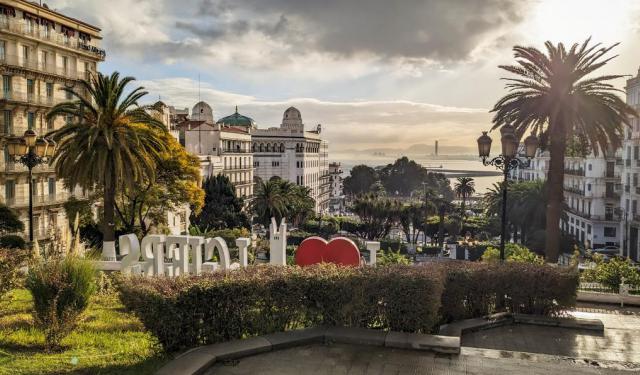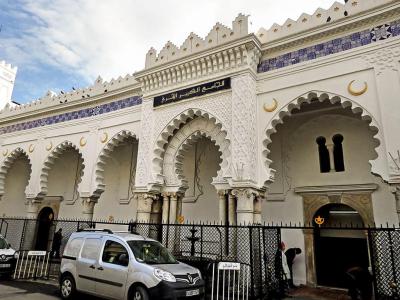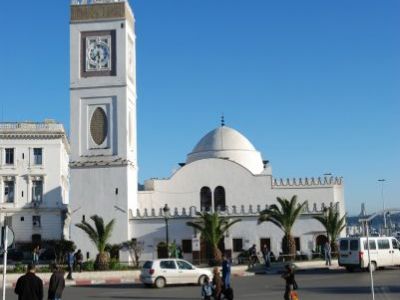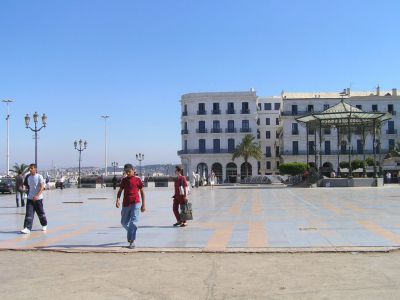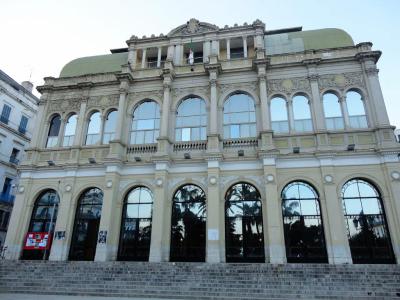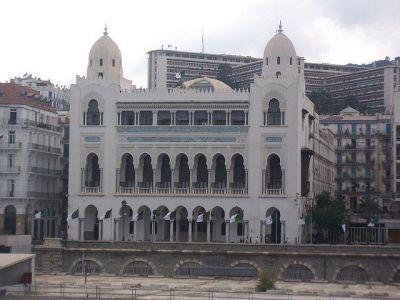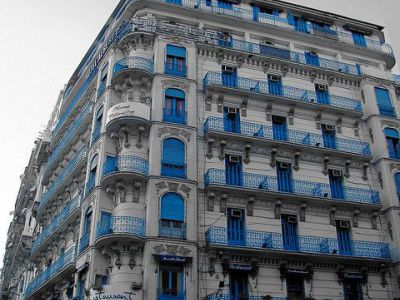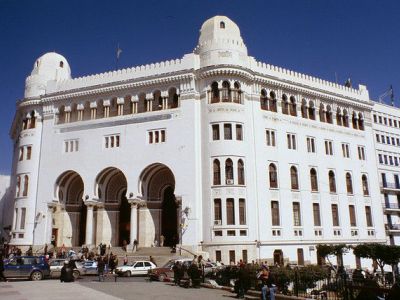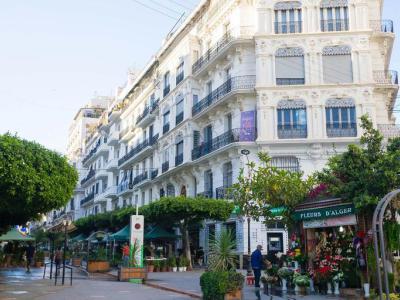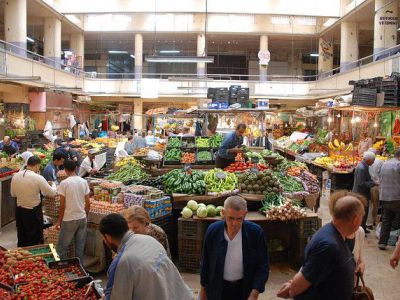Algiers Introduction Walking Tour (Self Guided), Algiers
The great Spanish writer Miguel de Cervantes spent five years in Algiers, from 1575 to 1580, as a prisoner of war. The stay left an an indelible mark on his work, from plays to the monumental work "Don Quixote."
Algiers, the capital of Algeria, also known as "The Joyous" (el-Behdja) or "Algiers the White" (Alger la Blanche) for its whitewashed buildings, is a city where the Mediterranean Sea gently caresses the North African shoreline. Here, the echoes of history resonate from every nook and the pulse of modern life thrums with the dynamic vigor of an evolving metropolis.
The name "Algiers" is believed to have originated from the Arabic "al-jazā'ir," meaning "the islands," referencing the four former islands that lay off the city's coast before becoming part of the mainland in 1525.
Algiers traces its origins to Carthaginian times, evolving under Roman rule as the settlement called “Icosium”. Today, Roman remnants still dot the modern marine quarter.
The present city was established in 944, after the Muslim conquest, with its control shifting among Berber dynasties and empires like the Almohads and Ziyanids. Spanish occupation of the region in 1302 marked a turning point, fostering trade and attracting Moorish refugees. The city gained prominence after the expulsion of Moors from Spain and Spanish efforts to suppress Barbary pirates in the 16th century.
In 1529, corsair Hayreddin Barbarossa recaptured Algiers from the Spaniards, inviting the Ottoman sovereignty. Though formally part of the Ottoman Empire, Algiers became an independently operated hub for piracy, thriving on ransoming, due to its strategic location. One of the city's most iconic landmarks, the Corsairs Palace (Palais des Raïs) reminds us of the turbulent past as a stronghold for Barbary pirates.
From the French invasion in 1830 to Algeria's independence in 1962, Algiers' history intertwined with France's colonization. Throughout that period, European settlement surged, influencing the city's demographics and design. The Algiers Central Post Office, an architectural gem dating back to the French colonial era, is a testament to Algiers' enduring legacy as a crossroads of cultures.
Today, strolling along the bustling Didouche Mourad and Ferhat Boussad streets, you can soak in the city's lively atmosphere, where traditional markets coexist with modern boutiques and cafes.
If you seek an unconventional destination brimming with cultural richness, Algiers is an undiscovered gem awaiting exploration. No longer a hub for pirates, today Algiers welcomes tourists from all over the world. We, hereby, invite you to delve into the premier attractions of this Algerian marvel featured in our self-guided walk and experience firsthand the allure of this dynamic city!
Algiers, the capital of Algeria, also known as "The Joyous" (el-Behdja) or "Algiers the White" (Alger la Blanche) for its whitewashed buildings, is a city where the Mediterranean Sea gently caresses the North African shoreline. Here, the echoes of history resonate from every nook and the pulse of modern life thrums with the dynamic vigor of an evolving metropolis.
The name "Algiers" is believed to have originated from the Arabic "al-jazā'ir," meaning "the islands," referencing the four former islands that lay off the city's coast before becoming part of the mainland in 1525.
Algiers traces its origins to Carthaginian times, evolving under Roman rule as the settlement called “Icosium”. Today, Roman remnants still dot the modern marine quarter.
The present city was established in 944, after the Muslim conquest, with its control shifting among Berber dynasties and empires like the Almohads and Ziyanids. Spanish occupation of the region in 1302 marked a turning point, fostering trade and attracting Moorish refugees. The city gained prominence after the expulsion of Moors from Spain and Spanish efforts to suppress Barbary pirates in the 16th century.
In 1529, corsair Hayreddin Barbarossa recaptured Algiers from the Spaniards, inviting the Ottoman sovereignty. Though formally part of the Ottoman Empire, Algiers became an independently operated hub for piracy, thriving on ransoming, due to its strategic location. One of the city's most iconic landmarks, the Corsairs Palace (Palais des Raïs) reminds us of the turbulent past as a stronghold for Barbary pirates.
From the French invasion in 1830 to Algeria's independence in 1962, Algiers' history intertwined with France's colonization. Throughout that period, European settlement surged, influencing the city's demographics and design. The Algiers Central Post Office, an architectural gem dating back to the French colonial era, is a testament to Algiers' enduring legacy as a crossroads of cultures.
Today, strolling along the bustling Didouche Mourad and Ferhat Boussad streets, you can soak in the city's lively atmosphere, where traditional markets coexist with modern boutiques and cafes.
If you seek an unconventional destination brimming with cultural richness, Algiers is an undiscovered gem awaiting exploration. No longer a hub for pirates, today Algiers welcomes tourists from all over the world. We, hereby, invite you to delve into the premier attractions of this Algerian marvel featured in our self-guided walk and experience firsthand the allure of this dynamic city!
How it works: Download the app "GPSmyCity: Walks in 1K+ Cities" from Apple App Store or Google Play Store to your mobile phone or tablet. The app turns your mobile device into a personal tour guide and its built-in GPS navigation functions guide you from one tour stop to next. The app works offline, so no data plan is needed when traveling abroad.
Algiers Introduction Walking Tour Map
Guide Name: Algiers Introduction Walking Tour
Guide Location: Algeria » Algiers (See other walking tours in Algiers)
Guide Type: Self-guided Walking Tour (Sightseeing)
# of Attractions: 10
Tour Duration: 2 Hour(s)
Travel Distance: 3.9 Km or 2.4 Miles
Author: Cathy
Sight(s) Featured in This Guide:
Guide Location: Algeria » Algiers (See other walking tours in Algiers)
Guide Type: Self-guided Walking Tour (Sightseeing)
# of Attractions: 10
Tour Duration: 2 Hour(s)
Travel Distance: 3.9 Km or 2.4 Miles
Author: Cathy
Sight(s) Featured in This Guide:
- Palais des Raïs (Corsairs Palace)
- Mosquee Djamaa el-Kebir (Djamaa el-Kebir Mosque)
- Mosquee Djamaa el-Djedid (Djamaa el-Djedid Mosque)
- Place des Martyrs (Martyrs' Square)
- Algerian National Theater
- Alger Prefecture
- Hotel Albert Le 1er
- Grande Poste d'Alger (Algiers Central Post Office)
- Rue Didouche Mourad (Didouche-Mourad Street)
- Rue Ferhat Boussad (Ferhat Boussad Street)
1) Palais des Raïs (Corsairs Palace) (must see)
The Corsairs Palace, also known as the Toppana or Bastion 23, is a remarkable architectural complex located along the seafront. Constructed in the 16th century during the AH 10th century, this palace complex comprises four palaces and several ancillary buildings spread across an area spanning more than half a hectare. Commissioned by Ramdan and Mustafa Pasha, it served as a residence for raïs (corsairs) and seafarers during its early history.
Despite the extensive demolition of the marine quarter carried out during the initial years of French Occupation, the Corsairs Palace, along with the Great Mosque and the Mosque of the Fisheries, managed to evade destruction. This preservation adds to its historical significance, offering visitors a glimpse into Algiers' maritime heritage and architectural legacy.
The restoration efforts undertaken in the 1990s have breathed new life into the Palace of the Raïs, sparking academic debates surrounding its authenticity and historical accuracy. However, these restoration endeavors have successfully recreated the ambiance of both the interior and exterior spaces, meticulously preserving elements such as the faïence wall cladding, woodwork, wrought iron bars, marble, corbels, alleyways, and covered passageways known as sabbat.
Despite the extensive demolition of the marine quarter carried out during the initial years of French Occupation, the Corsairs Palace, along with the Great Mosque and the Mosque of the Fisheries, managed to evade destruction. This preservation adds to its historical significance, offering visitors a glimpse into Algiers' maritime heritage and architectural legacy.
The restoration efforts undertaken in the 1990s have breathed new life into the Palace of the Raïs, sparking academic debates surrounding its authenticity and historical accuracy. However, these restoration endeavors have successfully recreated the ambiance of both the interior and exterior spaces, meticulously preserving elements such as the faïence wall cladding, woodwork, wrought iron bars, marble, corbels, alleyways, and covered passageways known as sabbat.
2) Mosquee Djamaa el-Kebir (Djamaa el-Kebir Mosque)
Djamaa el-Kebir, also known as the Great Mosque of Algiers, stands as a timeless testament to Algeria's rich architectural heritage and religious significance. Constructed in 1097 under the patronage of Sultan Ali ibn Yusuf, it ranks among the oldest mosques not only in Algiers but also in Algeria as a whole.
At the heart of Djamaa el-Kebir lies a rectangular courtyard measuring 38 by 46 meters, laid out in a traditional 9 by 11 grid pattern. This layout, replicated in numerous religious structures, reflects the mosque's adherence to classical Islamic architectural principles. The main mosque, originally built in 1097, features a striking minaret dating back to 1332, constructed by the Ziyyanid sultan of Tlemcen. The minaret, located on the northwest corner, stands as a majestic beacon of faith, its elegant design embodying the mosque's enduring spiritual significance.
Throughout its long history, Djamaa el-Kebir has undergone several modifications and enhancements. Notably, the gallery surrounding the main mosque was added in 1840, enriching its architectural grandeur and providing space for worshippers to gather and pray. Constructed from a combination of stone, brick, roofing tiles, and wood, the mosque's materials reflect the craftsmanship and ingenuity of its builders. Ornamentation, including intricate ceramics and woodwork, further enhances the mosque's aesthetic appeal, creating a serene and awe-inspiring sanctuary for believers.
At the heart of Djamaa el-Kebir lies a rectangular courtyard measuring 38 by 46 meters, laid out in a traditional 9 by 11 grid pattern. This layout, replicated in numerous religious structures, reflects the mosque's adherence to classical Islamic architectural principles. The main mosque, originally built in 1097, features a striking minaret dating back to 1332, constructed by the Ziyyanid sultan of Tlemcen. The minaret, located on the northwest corner, stands as a majestic beacon of faith, its elegant design embodying the mosque's enduring spiritual significance.
Throughout its long history, Djamaa el-Kebir has undergone several modifications and enhancements. Notably, the gallery surrounding the main mosque was added in 1840, enriching its architectural grandeur and providing space for worshippers to gather and pray. Constructed from a combination of stone, brick, roofing tiles, and wood, the mosque's materials reflect the craftsmanship and ingenuity of its builders. Ornamentation, including intricate ceramics and woodwork, further enhances the mosque's aesthetic appeal, creating a serene and awe-inspiring sanctuary for believers.
3) Mosquee Djamaa el-Djedid (Djamaa el-Djedid Mosque)
Djamaa el-Djedid, commonly referred to as the "New Mosque," is a captivating architectural gem nestled near the Place of Martyrs. Despite its name, which suggests modernity, this mosque boasts a rich history dating back to 1660, making it one of the oldest surviving mosques in the city.
What sets Djamaa el-Djedid Mosque apart is its unique blend of architectural styles, reflecting the diverse influences that have shaped Algeria's cultural landscape over the centuries. From Byzantine and Italian to Turkish influences, the mosque's structure seamlessly integrates elements from various traditions, creating a harmonious and visually stunning masterpiece. As visitors approach the mosque, they are greeted by an impressive facade adorned with intricate details and ornate designs, each telling a story of the mosque's rich heritage.
Despite the passage of time and the dramatic changes that Algeria has undergone, Djamaa el-Djedid Mosque has stood the test of time, serving as a symbol of resilience and continuity. Its architectural diversity is evident from every angle, with each side of the mosque offering a unique perspective on its intricate craftsmanship and historical significance. However, it's worth noting that the mosque occasionally closes its doors to non-Muslim visitors, preserving its sacred space for worship and reflection in accordance with Islamic tradition.
What sets Djamaa el-Djedid Mosque apart is its unique blend of architectural styles, reflecting the diverse influences that have shaped Algeria's cultural landscape over the centuries. From Byzantine and Italian to Turkish influences, the mosque's structure seamlessly integrates elements from various traditions, creating a harmonious and visually stunning masterpiece. As visitors approach the mosque, they are greeted by an impressive facade adorned with intricate details and ornate designs, each telling a story of the mosque's rich heritage.
Despite the passage of time and the dramatic changes that Algeria has undergone, Djamaa el-Djedid Mosque has stood the test of time, serving as a symbol of resilience and continuity. Its architectural diversity is evident from every angle, with each side of the mosque offering a unique perspective on its intricate craftsmanship and historical significance. However, it's worth noting that the mosque occasionally closes its doors to non-Muslim visitors, preserving its sacred space for worship and reflection in accordance with Islamic tradition.
4) Place des Martyrs (Martyrs' Square)
The Martyrs' Square, formerly known as the Government Square during French occupation, is a historic square located in the heart of Algiers. Covering an area of approximately one thousand square meters, this square holds immense cultural and historical significance for the Algerian people. Over the years, it has served various purposes, reflecting the evolution of Algerian society and its struggle for independence.
During the 1990s, a turbulent period in Algerian history, the Martyrs' Square became a focal point for social and cultural activities. It transformed into a vibrant hub for theater performances, concerts, and even football matches, attracting people from all walks of life. The square's versatility and central location made it an ideal venue for community gatherings and artistic expression.
At the heart of the Martyrs' Square stands the Musical Kiosque (Kiosque à Musique), a pavilion that once hosted a wide range of concerts organized by Algerian musicians. This iconic structure symbolizes the cultural vibrancy of Algiers and serves as a reminder of the city's rich musical heritage. The square's layout and architectural elements reflect its historical significance as a central gathering place for the people of Algiers.
During the 1990s, a turbulent period in Algerian history, the Martyrs' Square became a focal point for social and cultural activities. It transformed into a vibrant hub for theater performances, concerts, and even football matches, attracting people from all walks of life. The square's versatility and central location made it an ideal venue for community gatherings and artistic expression.
At the heart of the Martyrs' Square stands the Musical Kiosque (Kiosque à Musique), a pavilion that once hosted a wide range of concerts organized by Algerian musicians. This iconic structure symbolizes the cultural vibrancy of Algiers and serves as a reminder of the city's rich musical heritage. The square's layout and architectural elements reflect its historical significance as a central gathering place for the people of Algiers.
5) Algerian National Theater
The Algerian National Theater, inaugurated on September 29, 1853, stands as a proud architectural marvel crafted in the neo-baroque style. Originally conceived by a French architect, this majestic structure was initially intended for construction in Government Square (now Martyrs Square). However, the colonial authorities of the time opted for its placement along the axis of Bryson Square, later known as Port Said. Notably, the theater was erected on the grounds of the former barracks of the Turkish guards, adding a layer of historical significance to its grandeur.
Throughout its illustrious history, the Algerian National Theater has served as a prestigious venue for a diverse array of world-renowned performing arts ensembles. From the grandeur of the Bolshoi Ballet to the captivating performances of the Peking Opera, and from the traditional Japanese Theatre to the sophisticated productions of the Piccolo Theater in Milan, this theater has hosted an impressive lineup of international talent. Additionally, it has been a platform for showcasing the symphony orchestras and national performances from countries such as Syria and Egypt, further enriching the cultural tapestry of Algeria.
Beyond its architectural splendor and role as a cultural beacon, the Algerian National Theater has played a vital role in fostering artistic exchange and promoting cultural diplomacy. By welcoming esteemed performers from across the globe and showcasing diverse artistic traditions, it has contributed to the enrichment of Algeria's cultural landscape while fostering connections with the international community.
Throughout its illustrious history, the Algerian National Theater has served as a prestigious venue for a diverse array of world-renowned performing arts ensembles. From the grandeur of the Bolshoi Ballet to the captivating performances of the Peking Opera, and from the traditional Japanese Theatre to the sophisticated productions of the Piccolo Theater in Milan, this theater has hosted an impressive lineup of international talent. Additionally, it has been a platform for showcasing the symphony orchestras and national performances from countries such as Syria and Egypt, further enriching the cultural tapestry of Algeria.
Beyond its architectural splendor and role as a cultural beacon, the Algerian National Theater has played a vital role in fostering artistic exchange and promoting cultural diplomacy. By welcoming esteemed performers from across the globe and showcasing diverse artistic traditions, it has contributed to the enrichment of Algeria's cultural landscape while fostering connections with the international community.
6) Alger Prefecture
Constructed in 1904, the Alger Prefecture, also referred to as the Wilaya building, stands as an architectural gem in the heart of the city. This historic edifice boasts a unique blend of architectural styles, with the predominant influence being Neo-Moorish colonial design. Its striking snow-white walls command attention, making it a prominent landmark in the urban landscape of Algiers. Adorned with intricate engravings and ornate decorations, the facade of the Prefecture exudes grandeur and elegance.
One of the defining features of the Alger Prefecture is its majestic pillars, which lend the building an air of aristocratic charm. These pillars not only provide structural support but also contribute to the building's overall aesthetic appeal, adding to its architectural significance. Designed by architect Henri Petit, the Prefecture showcases his mastery in blending various architectural elements to create a harmonious and visually captivating structure.
Over the years, the Alger Prefecture has served as a symbol of administrative authority and governmental presence in Algiers. Beyond its functional role as a government building, it stands as a testament to Algeria's rich architectural heritage and colonial history. As a notable example of Neo-Moorish colonial architecture, the Prefecture represents a significant era in Algerian history and continues to be appreciated for its architectural beauty and cultural significance.
One of the defining features of the Alger Prefecture is its majestic pillars, which lend the building an air of aristocratic charm. These pillars not only provide structural support but also contribute to the building's overall aesthetic appeal, adding to its architectural significance. Designed by architect Henri Petit, the Prefecture showcases his mastery in blending various architectural elements to create a harmonious and visually captivating structure.
Over the years, the Alger Prefecture has served as a symbol of administrative authority and governmental presence in Algiers. Beyond its functional role as a government building, it stands as a testament to Algeria's rich architectural heritage and colonial history. As a notable example of Neo-Moorish colonial architecture, the Prefecture represents a significant era in Algerian history and continues to be appreciated for its architectural beauty and cultural significance.
7) Hotel Albert Le 1er
Situated in a prime location near the Grand Post Office, Hotel Albert Le 1er stands as a historic landmark in the bustling city center. Constructed between 1929 and 1930, this six-story hotel boasts a distinguished architectural design characterized by intricate details and sophisticated iron balconies adorning each floor. The building's exterior features a harmonious combination of white and blue hues, blending seamlessly with the surrounding buildings in the Casbah area, a UNESCO World Heritage site renowned for its historical significance and architectural beauty.
What sets Hotel Albert Le 1er apart from its neighboring structures are the striking golden embellishments that adorn its exterior, adding a touch of opulence and grandeur to its façade. These golden accents serve as eye-catching highlights against the backdrop of the hotel's predominantly white and blue color scheme, enhancing its visual appeal and making it a notable architectural gem in Algiers.
Beyond its architectural significance, Hotel Albert Le 1er has played a role in shaping the social and cultural fabric of Algiers, serving as a gathering place for travelers and locals alike. Over the years, it has welcomed guests from around the world, offering them a blend of comfort, luxury, and hospitality.
What sets Hotel Albert Le 1er apart from its neighboring structures are the striking golden embellishments that adorn its exterior, adding a touch of opulence and grandeur to its façade. These golden accents serve as eye-catching highlights against the backdrop of the hotel's predominantly white and blue color scheme, enhancing its visual appeal and making it a notable architectural gem in Algiers.
Beyond its architectural significance, Hotel Albert Le 1er has played a role in shaping the social and cultural fabric of Algiers, serving as a gathering place for travelers and locals alike. Over the years, it has welcomed guests from around the world, offering them a blend of comfort, luxury, and hospitality.
8) Grande Poste d'Alger (Algiers Central Post Office) (must see)
Built in the Neo-Moorish style and popularized by renowned architect Charles Célestin Jonnart, the iconic Algiers Central Post Office is a striking example of French colonial architecture. Designed by the talented architects Voinot and Tondoire, the Algiers Central Post Office was commissioned by the French Postal Service, a formidable institution during the era of the French colonial empire.
The grandeur of the Algiers Central Post Office is evident in its exquisite design and ornate details. The main facade features three arched entrances, adorned with intricate carvings and decorative elements characteristic of the Neo-Moorish style. The upper gallery is embellished with twinned columns, adding to the building's architectural elegance. The main doors, crafted from high-quality wood, exude craftsmanship and attention to detail, welcoming visitors into the majestic interior of the building.
Inside, the Algiers Central Post Office boasts a magnificent main room, distinguished by its soaring ceilings and architectural splendor. The intricate ceiling design is a marvel to behold, showcasing the craftsmanship and artistic ingenuity of the architects and artisans involved in its construction.
The grandeur of the Algiers Central Post Office is evident in its exquisite design and ornate details. The main facade features three arched entrances, adorned with intricate carvings and decorative elements characteristic of the Neo-Moorish style. The upper gallery is embellished with twinned columns, adding to the building's architectural elegance. The main doors, crafted from high-quality wood, exude craftsmanship and attention to detail, welcoming visitors into the majestic interior of the building.
Inside, the Algiers Central Post Office boasts a magnificent main room, distinguished by its soaring ceilings and architectural splendor. The intricate ceiling design is a marvel to behold, showcasing the craftsmanship and artistic ingenuity of the architects and artisans involved in its construction.
9) Rue Didouche Mourad (Didouche-Mourad Street) (must see)
Didouche-Mourad Street is a historically significant thoroughfare. Even before Algeria's independence, rue Michelet was renowned for its vibrant array of shops and bustling shopping atmosphere. Today, under its new name, Didouche Mourad Street, this iconic street has managed to retain its distinctive character and essence.
Stretching for over a kilometer, a leisurely stroll along Didouche-Mourad Street starting from Grand Post Office is a delightful invitation to indulge in shopping and exploration. As one makes their way from Maurice Audin Square to Khemisti Boulevard, the shops take on a more upscale and international appeal. Boutiques offering ready-to-wear fashion, antiques, handcrafted treasures, Tuareg jewelry emporiums, perfumeries, and bookstores adorn this lively avenue, tempting visitors with a diverse shopping experience.
What adds to the charm of this bustling street is its architectural diversity, with buildings that seamlessly blend Mediterranean and Parisian influences. This fusion of styles creates a unique ambiance that evokes a sense of both local and international flavors.
Amidst the hustle and bustle of Didouche Mourad, one cannot help but be drawn to the numerous cafes that line the street. These establishments provide an ideal opportunity to pause, savor a cup of coffee or tea, and immerse oneself in the lively atmosphere that is steeped in the rich history of this vibrant Algerian avenue.
Stretching for over a kilometer, a leisurely stroll along Didouche-Mourad Street starting from Grand Post Office is a delightful invitation to indulge in shopping and exploration. As one makes their way from Maurice Audin Square to Khemisti Boulevard, the shops take on a more upscale and international appeal. Boutiques offering ready-to-wear fashion, antiques, handcrafted treasures, Tuareg jewelry emporiums, perfumeries, and bookstores adorn this lively avenue, tempting visitors with a diverse shopping experience.
What adds to the charm of this bustling street is its architectural diversity, with buildings that seamlessly blend Mediterranean and Parisian influences. This fusion of styles creates a unique ambiance that evokes a sense of both local and international flavors.
Amidst the hustle and bustle of Didouche Mourad, one cannot help but be drawn to the numerous cafes that line the street. These establishments provide an ideal opportunity to pause, savor a cup of coffee or tea, and immerse oneself in the lively atmosphere that is steeped in the rich history of this vibrant Algerian avenue.
10) Rue Ferhat Boussad (Ferhat Boussad Street)
Ferhat Boussad Street, previously named Meissonier Street, stands as one of the bustling thoroughfares in Algiers. Renowned for its vibrant atmosphere and bustling commerce, the street teems with a myriad of shops, boutiques, and cafes, attracting locals and visitors alike. The street is characterized by its lively ambiance, with crowds of people navigating through the diverse array of establishments that line its sidewalks.
On either side of Ferhat Boussad Street, a plethora of shops and businesses vie for attention, creating a dynamic and bustling environment. From family-owned boutiques to cozy cafes, the street offers a diverse range of options for shoppers and diners. Many of these establishments are family-run businesses, known for their personalized service and welcoming atmosphere, providing a contrast to larger corporate stores.
Visitors to Ferhat Boussad Street can explore a wide variety of shops catering to various needs and interests. Whether one is in search of fresh baked goods, exquisite jewelry, or captivating books, the street boasts a diverse selection of stores to peruse. Additionally, essential services such as butchers, florists, and chemists are readily available, offering convenience and accessibility to residents and visitors alike. Furthermore, the street is home to a bustling green market, where vendors offer an array of fresh fruits and vegetables, adding to the vibrant tapestry of offerings along Ferhat Boussad Street.
On either side of Ferhat Boussad Street, a plethora of shops and businesses vie for attention, creating a dynamic and bustling environment. From family-owned boutiques to cozy cafes, the street offers a diverse range of options for shoppers and diners. Many of these establishments are family-run businesses, known for their personalized service and welcoming atmosphere, providing a contrast to larger corporate stores.
Visitors to Ferhat Boussad Street can explore a wide variety of shops catering to various needs and interests. Whether one is in search of fresh baked goods, exquisite jewelry, or captivating books, the street boasts a diverse selection of stores to peruse. Additionally, essential services such as butchers, florists, and chemists are readily available, offering convenience and accessibility to residents and visitors alike. Furthermore, the street is home to a bustling green market, where vendors offer an array of fresh fruits and vegetables, adding to the vibrant tapestry of offerings along Ferhat Boussad Street.
The Most Popular Cities
/ view all
